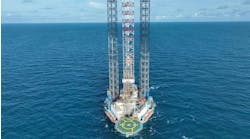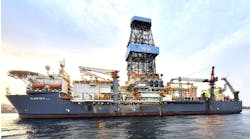Another horizontal gravel packing record was set with a 7,324 ft comp-letion in the Texaco-operated Captain field in the UK North Sea, in which Korean Captain Company Ltd. is a partner. The event surpassed the previous horizontal gravel packing record of 4,000 ft, which was set in November 1998.
In May 2001, the Texaco Captain 13/22a - B2 well was completed at a total depth of 19,990 ft measured depth as an open-hole gravel pack using a 5 1/2-in. by 230 micron with medium weave screens. Prior to the completion, the well consisted of a 11 3/4-in. by 9 5/8-in. tapered casing string set at 7,048 ft measured depth (MD) and a drilled 8 1/2-in. hole to a total depth of 14,372 ft MD. The horizontal section was begun at a true vertical depth of 2,915 ft.
Packing objectives
The objective of gravel packing was to stabilize the open hole, prevent formation sand movement, and protect screens from plugging and erosion. The resulting completion should provide reliable long-term well productivity and enhanced reservoir drainage, according to the producer and service company. To accomplish these objectives, Texaco and Baker designed and implemented a systems approach that integrates customized drill-in fluids, high-rate displacement and hole cleaning procedures, and Baker Oil Tools' proprietary extended-longevity sand control screen, CS-300 open hole gravel packing system, BetaBreaker valves, and the company's proprietary fluid loss control valve.
The completion procedure was designed to control fluid loss in the horizontal section with very high permeability (1-12 darcys) and a very small operating window between formation pressure and fracture pressure.
Completion operations
The horizontal hole was drilled with a 9.6-ppg water-based calcium carbonate drill-in fluid. Then, the entire well was displaced to 9.6 ppg filtered sodium chloride/potassium chloride (NaCl/KCl) brine using a high rate well displacement. The cleanliness of the brine returns from the well were less than 0.01% solids content, prior to deploying the gravel pack assembly.
The gravel pack assembly with 4-in. internal washpipe string and open hole gravel pack service tools was successfully deployed in the well. A Model "SC-2R" packer was set at 6,827 ft MD. The end of the screen assembly was at 13,990 ft MD. The service tools, designed to maintain hydrostatic pressure on the open hole filter cake, were successfully released from the packer and the various circulating positions were confirmed. In addition, four BetaBreaker valves were run in the washpipe to assist in maintaining bottomhole treating pressure below fracture pressure.
In May 2001, the Texaco Captain 13/22a-B2 well was completed at a total depth of 19,990 ft measured depth as an open-hole gravel pack.
Using horizontal gravel pack design software, engineers determined the required pump rate and gravel concentration to pack the well. The well was successfully gravel packed with 174,920 lb of 16/30-gravel pack sand or 104% of the open hole annular volume calculated from the measurement-while-drilling ADN caliper log. Completion brine was used as the gravel carrier fluid.
Approximately 70% returns were maintained while pumping the gravel pack, which took 60 hours. Sand loading was maintained at a very low level (average 0.15 ppga) throughout the job. During pumping, all four valves operated as designed, allowing the treatment to be pumped at a constant rate of 7 bbl/min. without exceeding fracture pressure. After the gravel pack screened out, the excess gravel was successfully circulated from the workstring, and the service string was then pulled above the fluid loss control valve. Prior to closing, the valve losses of 60 bbl/hr were noted, and losses were reduced to zero when the valve was closed.
Earlier completions
The first of the 4,000-ft horizontal gravel packs was installed in Captain in November 1998, following technical, operations, and logistics planning. Using a brine carrier fluid, 137,000 lb of gravel was placed in the annulus between the borehole and the sand control screen. Gravel placement was successful despite the presence of a non-cemented open hole sidetrack in the final 4,000-ft-long horizontal interval.
The gravel-packed wells in the field have exhibited more consistent well productivities in line with reservoir performance expectations and with no signs of plugging. As the need to gravel pack laterals of increasing length continues, new technology has been and will continued to be developed to meet these challenges.




